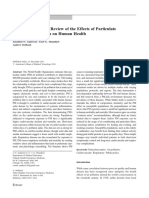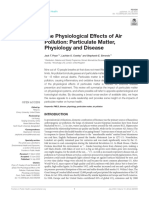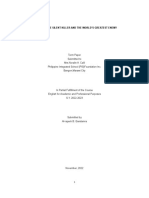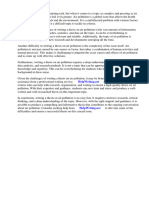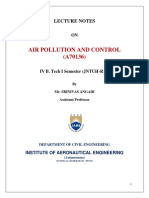Chem Project Help
Chem Project Help
Uploaded by
Rahul KumarCopyright:
Available Formats
Chem Project Help
Chem Project Help
Uploaded by
Rahul KumarOriginal Description:
Original Title
Copyright
Available Formats
Share this document
Did you find this document useful?
Is this content inappropriate?
Copyright:
Available Formats
Chem Project Help
Chem Project Help
Uploaded by
Rahul KumarCopyright:
Available Formats
The large number of deaths and other health problems associated with particulate pollution was first demonstrated
in the early 1970s [6] and has been reproduced many times since. PM pollution is estimated to cause 22,000-52,000 deaths per year in the United States (from 2000)[7] and 200,000 deaths per year in Europe. The effects of inhaling particulate matter that have been widely studied in humans and animals now include asthma, lung cancer, cardiovascular issues, birth defects, and premature death. The size of the particle is a main determinant of where in the respiratory tract the particle will come to rest when inhaled. Because of their small size, particles on the order of ~10 micrometers or less (PM10) can penetrate the deepest part of the lungs such as the bronchioles or alveoli.[8] Larger particles are generally filtered in the nose and throat via cilia and mucus, but particulate matter smaller than about 10 micrometers, referred to as PM10, can settle in the bronchi and lungs and cause health problems. The 10 micrometer size does not represent a strict boundary between respirable and non-respirable particles, but has been agreed upon for monitoring of airborne particulate matter by most regulatory agencies. Similarly, particles smaller than 2.5 micrometers, PM2.5, tend to penetrate into the gas exchange regions of the lung, and very small particles (< 100 nanometers) may pass through the lungs to affect other organs. In particular, a study published in the Journal of the American Medical Association indicates that PM2.5 leads to high plaque deposits in arteries, causing vascular inflammation and atherosclerosis a hardening of the arteries that reduces elasticity, which can lead to heart attacks and other cardiovascular problems.[9] Researchers suggest that even short-term exposure at elevated concentrations could significantly contribute to heart disease. A study in The Lancet concluded that traffic exhaust is the single most serious preventable cause of heart attack in the general public, the cause of 7.4% of all attacks.[10] The site and extent of absorption of inhaled gases and vapors are determined by their solubility in water. Absorption is also dependent upon air flow rates and the partial pressure of the gases in the inspired air. The fate of a specific contaminate is dependent upon the form in which it exists (aerosol or particulate). Inhalation also depends upon the breathing rate of the subject. [11] The smallest particles, less than 100 nanometers (nanoparticles), may be even more damaging to the cardiovascular system.[12] There is evidence that particles smaller than 100 nanometers can pass through cell membranes and migrate into other organs, including the brain. It has been suggested that particulate matter can cause similar brain damage as that found in Alzheimer patients. Particles emitted from modern diesel engines (commonly referred to as Diesel Particulate Matter, or DPM) are typically in the size range of 100 nanometers (0.1 micrometer). In addition, these soot particles also carry carcinogenic components like benzopyrenes adsorbed on their surface. It is becoming increasingly clear that the legislative limits for engines, which are in terms of emitted mass, are not a proper measure of the health hazard. One particle of 10 m diameter has approximately the same mass as 1 million particles of 100 nm diameter, but it is clearly much less hazardous, as it probably never enters the human body and if it does, it is quickly removed. Proposals for new regulations exist in some countries, with suggestions to limit the particle surface area or the particle number.
A further complexity that is not entirely documented is how the shape of PM can affect health. Of course the dangerous feathery shape of asbestos is widely recognised to lodge itself in the lungs with often dire consequences. Geometrically angular shapes have more surface area than rounder shapes, which in turn affects the binding capacity of the particle to other, possibly more dangerous substances. The inhalable dust fraction is the fraction of dust that enters the nose and mouth and may be deposited anywhere in the respiratory tract. The thoracic fraction is the fraction that enters the thorax and is deposited within the lung airways and the gas-exchange regions. The respiratory fraction is what is deposited in the gas exchangeregions (alveoli). [13]
[edit] Public Health Effects
Researchers at the Johns Hopkins Bloomberg School of Public Health have conducted the largest nationwide study on the acute health effects of coarse particle pollution. Coarse particles are airborne pollutants that fall between 2.5 and 10 micrometers in diameter.[14] The study, published in the May 14, 2008, edition of JAMA, found evidence of an association with hospital admissions for cardiovascular diseases but no evidence of an association with the number of hospital admissions for respiratory diseases. After taking into account fine particle levels, the association with coarse particles remained but was no longer statistically significant. Health effects on the public are considered to be caused by climate change, which is determined to be a result of increased global temperatures. An increased burden of malnutrition, diahhreal, cardio-respiratory, and infectious diseases, in addition to an increased morbidity and mortality caused by heat waves, floods, and droughts are all thought to be public health effects of global warming. Alarmingly, a change in the distribution of disease vectors, such as insects, is affecting public health, and thought to be initiated by climate change and air pollution. [15] The primary health concern caused by air pollution, and particulate matter specifically is cardiovascular and respiratory diseases. The idea is that the earth has reached its carrying capacity and our ecological footprint is high across the world, and increasing. The rise of CVD as the leading cause of death in America and developing countries, and the world in general, is resulting in premature mortality that can directly be linked to air pollution. [16]
Particulate matter studies in Bangkok Thailand indicated a 1.9% increased risk of dying from cardiovascular disease, and 1.0% risk of all disease for every 10 micrograms per cubic meter. Levels averaged 65 in 1996, 68 in 2002, and 52 in 2004. Decreasing levels may be attributed to conversions of diesel to natural gas combustion as well as improved regulations.[17] The Mongolian government agency has recorded a 45% increase in the rate of respiratory illness in the past five years. Bronchial asthma, chronic obstructive pulmonary disease and interstitial pneumonia are the most common ailments treated by area hospitals. Levels of premature death, chronic bronchitis, and cardiovascular disease are increasing at a rapid rate. [18]
[edit] Effects on vegetation
Particulate matter can clog stomatal openings of plants and interfere with photosynthesis functions.[19] In this manner high particulate matter concencentrations in the atmosphere can lead to growth stunting or mortality in some plant species.
[edit] Climate effects
Climate effects can be extremely catastrophic; sulfur dioxide ejected from the eruption of Huaynaputina probably caused the Russian famine of 1601 - 1603, leading to the deaths of two million. Particles can affect the climate in two different ways. The "direct effect" is caused by the fact that the particles scatter and absorb solar and infrared radiation in the atmosphere.[20] The "indirect effect" of particles are more complex and more difficult to assess. Changes in the concentration of aerosols and PM in the atmosphere cause variations in the density and size of cloud droplets. There is a set amount of water available for clouds. The water can form large droplets within the clouds, which causes precipitation (a major removal mechanism for aerosols and source of acid rain). The addition of PM into the atmosphere causes the water to condense on to the particles. This results in more, but smaller droplets in the clouds, which increases the cloud albedo. In addition to increasing the albedo, this effect tends to decrease the chance of precipitation. If precipitation is suppressed, this results in excess water remaining in the atmosphere.[21] The primary concern for climate effects of air pollution is an increase in global average temperatures. Greenhouse gases produced as a result of human activity trap heat in earth's atmosphere, warming the surface. Urbanization and industrialization is the main cause of airborn particulate matter, and so it follows that air pollution is a more serious threat in densely populated areas. Electricity and heat produced by antiquated methods such as wood burning and coal combustion is still the primary method for sustaining everyday life in developing countries. Climate effects inevitably lead to health effects, which are listed above, but consist mainly of respiratory problems, cardiovascular disease, and premature death. [22]
You might also like
- ASHRAE STD 170 - Update PDFDocument12 pagesASHRAE STD 170 - Update PDFJAQA100% (1)
- Health Effect of SO2Document6 pagesHealth Effect of SO2Sajal DeeP SinGHNo ratings yet
- PollutionDocument27 pagesPollutionVishalNo ratings yet
- Air PollutionDocument16 pagesAir PollutionjeegarrojaNo ratings yet
- AlexisdoocxDocument5 pagesAlexisdoocxkaidanieljNo ratings yet
- BagofwordsDocument4 pagesBagofwordsjayshneeNo ratings yet
- Bu Env U-Iii Greenhouse Gas-: EffectDocument11 pagesBu Env U-Iii Greenhouse Gas-: Effectberarai50No ratings yet
- The Effects of Pollution On Health and The EnvironmentDocument25 pagesThe Effects of Pollution On Health and The Environmentjerichodecenilla98No ratings yet
- Air Pollution and Human Health: CommentaryDocument3 pagesAir Pollution and Human Health: CommentarybalqismezzalunaNo ratings yet
- INTRODUCTIONDocument14 pagesINTRODUCTIONmoses samuelNo ratings yet
- Clearing The Air: A Review of The Effects of Particulate Matter Air Pollution On Human HealthDocument10 pagesClearing The Air: A Review of The Effects of Particulate Matter Air Pollution On Human HealthnodNo ratings yet
- Environmental and Health Impacts of Air Pollution a Review - PMCDocument1 pageEnvironmental and Health Impacts of Air Pollution a Review - PMCscarab.upper-0zNo ratings yet
- Judah 302Document18 pagesJudah 302Ojo JudahNo ratings yet
- Fpubh 10 882569Document13 pagesFpubh 10 882569Katalin BodorNo ratings yet
- Chemistry Project ON: AIR PollutionDocument11 pagesChemistry Project ON: AIR PollutionanshuNo ratings yet
- Air Pollution in The World: Foundation Studies DepartmentDocument9 pagesAir Pollution in The World: Foundation Studies DepartmentBích Lê100% (1)
- Air Pollution Refers To The Release of Pollutants Into The AirDocument9 pagesAir Pollution Refers To The Release of Pollutants Into The Airsana jaleelNo ratings yet
- Presentation 1Document12 pagesPresentation 1bvyas2606No ratings yet
- Submitted By: Submitted To:: Srutika Chand Class: Xii "Science" Roll: Mr. Deepak Aggarawal H.O.D PhysicsDocument10 pagesSubmitted By: Submitted To:: Srutika Chand Class: Xii "Science" Roll: Mr. Deepak Aggarawal H.O.D PhysicsAshimNo ratings yet
- Air PollutionDocument2 pagesAir Pollutionslentkler035No ratings yet
- Write UpDocument4 pagesWrite Upbishtriya96No ratings yet
- Air Pollution and Cardiovascular Injury: Epidemiology, Toxicology, and MechanismsDocument8 pagesAir Pollution and Cardiovascular Injury: Epidemiology, Toxicology, and MechanismsEitavitaza Arzahzarah WillandNo ratings yet
- Health Effects: Common Disease Associated With Air Pollution and How PerventionDocument3 pagesHealth Effects: Common Disease Associated With Air Pollution and How PerventionYasin HusseinNo ratings yet
- Environmental Science ReportDocument13 pagesEnvironmental Science ReportMadhu ReddyNo ratings yet
- 1 s2.0 S1877042810011444 Main PentingDocument9 pages1 s2.0 S1877042810011444 Main PentingEitavitaza Arzahzarah WillandNo ratings yet
- Effects of Air Pollution On CdvsDocument32 pagesEffects of Air Pollution On Cdvsapi-640983441No ratings yet
- Pollution The SDocument15 pagesPollution The SWasil SaipodenNo ratings yet
- Ijerph 19 07511Document22 pagesIjerph 19 07511Katalin BodorNo ratings yet
- The Effect of Air Pollution in The Environment and The Public HealthDocument6 pagesThe Effect of Air Pollution in The Environment and The Public Healthlyne100% (1)
- Air Pollution Term Paper TopicsDocument8 pagesAir Pollution Term Paper Topicsafmyervganedba100% (1)
- Chapter 1Document5 pagesChapter 1ArthurNo ratings yet
- Persausive SpeechDocument4 pagesPersausive SpeechGregg MillerNo ratings yet
- Air PollutionDocument6 pagesAir PollutionMASTER PIECENo ratings yet
- Ijerph 15 00780 PDFDocument44 pagesIjerph 15 00780 PDFSanyamJainNo ratings yet
- AaaDocument1 pageAaaBlair SafaraNo ratings yet
- Air PollutionDocument19 pagesAir PollutionMika Hakimie100% (1)
- Air PollutionDocument33 pagesAir PollutionSpencer VenableNo ratings yet
- Emtech 2Document10 pagesEmtech 2Yasmine Grace EsguerraNo ratings yet
- Thesis ReportDocument45 pagesThesis ReportADARSHA COLLEGE OF ENGINEERING ANGULNo ratings yet
- AaaaDocument3 pagesAaaaNguyễn Minh Phúc ThànhNo ratings yet
- Updated DraftDocument8 pagesUpdated Draftmuhammad abuzarNo ratings yet
- Co - Relation of Air Pollution and Human Health-A Scientific ApproachDocument6 pagesCo - Relation of Air Pollution and Human Health-A Scientific Approachalisha kalraNo ratings yet
- Interactions of Climate Change, Air Pollution, and Human HealthDocument8 pagesInteractions of Climate Change, Air Pollution, and Human Healthchandgagan60No ratings yet
- Air Pollution ControlDocument9 pagesAir Pollution ControlMuhammad Khairuddin KassimNo ratings yet
- Environmental ScienceDocument30 pagesEnvironmental Science2021301152No ratings yet
- Air PollutionDocument3 pagesAir PollutionHifzhuddin HafizNo ratings yet
- What Effects Can The Environment Have On Health?: Physical Chemical Biological HazardsDocument11 pagesWhat Effects Can The Environment Have On Health?: Physical Chemical Biological Hazardssabreen hiresNo ratings yet
- What Is Air PollutionDocument2 pagesWhat Is Air Pollutionshaheen_banu2005No ratings yet
- Pollution and Respiratory Disease: Can Diet or Supplements Help? A ReviewDocument14 pagesPollution and Respiratory Disease: Can Diet or Supplements Help? A ReviewEgy SunandaNo ratings yet
- PollutionDocument15 pagesPollutionMT RANo ratings yet
- Thesis Air PollutionDocument4 pagesThesis Air Pollutionbdg8b37x100% (2)
- Air Pollution and Control (A70136) : Lecture NotesDocument102 pagesAir Pollution and Control (A70136) : Lecture NoteskavipriyaNo ratings yet
- Effects of Air Pollution On Human Health and Practical Measures For Prevention in IranDocument29 pagesEffects of Air Pollution On Human Health and Practical Measures For Prevention in IranSohaib ArshadNo ratings yet
- Alfarra PHD Thesis 1chapter1 IntroductionDocument16 pagesAlfarra PHD Thesis 1chapter1 IntroductionΧΡΙΣΤΙΝΑ ΣΤΑΜΑΤΗNo ratings yet
- 24201920083, Suprakash Mondal (Paper)Document16 pages24201920083, Suprakash Mondal (Paper)Suprakash MondalNo ratings yet
- Lab 8a Air QualityDocument12 pagesLab 8a Air Qualityapi-490226410No ratings yet
- Effects of Air Pollution On Human Health and Practical Measures For Prevention in Iran - PMCDocument24 pagesEffects of Air Pollution On Human Health and Practical Measures For Prevention in Iran - PMCBM40621 Anis Sahira Binti Mohd RidzauddinNo ratings yet
- Geography Project - Aadit Tuli 9E PDFDocument14 pagesGeography Project - Aadit Tuli 9E PDFAadit TuliNo ratings yet
- 1 The Changing Face of Air Pollution PDFDocument57 pages1 The Changing Face of Air Pollution PDFdzenitaNo ratings yet
- Silicone 350 Ccs MSDS 101014 PDFDocument5 pagesSilicone 350 Ccs MSDS 101014 PDFmeNo ratings yet
- Final 1 AsdaDocument16 pagesFinal 1 Asdaapi-511390817No ratings yet
- Reproduction in Human (Chapter 3) Teaching Notes - (Module 1)Document2 pagesReproduction in Human (Chapter 3) Teaching Notes - (Module 1)succiniNo ratings yet
- Shell Helix hx3Document2 pagesShell Helix hx3Babar KhanNo ratings yet
- MAPEHDocument3 pagesMAPEHGermaine Guimbarda MiguelesNo ratings yet
- Pre Participation Physical EvaluationDocument12 pagesPre Participation Physical EvaluationVenance AssenimNo ratings yet
- Environmental Studies-FIRST UNIT-vkmDocument59 pagesEnvironmental Studies-FIRST UNIT-vkmRandomNo ratings yet
- Nursing Care PlanDocument2 pagesNursing Care PlanAldrein GonzalesNo ratings yet
- Worm InfestationDocument4 pagesWorm InfestationSachin Dwivedi100% (3)
- Birmingham S Mcwane Inc With 10 Major Foundries Is One ofDocument1 pageBirmingham S Mcwane Inc With 10 Major Foundries Is One ofAmit PandeyNo ratings yet
- Emotion-Regulation Skills As A Treatment Target in Psychotherapy PDFDocument8 pagesEmotion-Regulation Skills As A Treatment Target in Psychotherapy PDFPaula Catalina Mendoza PrietoNo ratings yet
- Self Declaration Form Details For International Arriving PassengersDocument2 pagesSelf Declaration Form Details For International Arriving PassengersLala KamarudheenNo ratings yet
- Suicide & Millennials: Mind Wellness PresentsDocument79 pagesSuicide & Millennials: Mind Wellness PresentsPooja DasNo ratings yet
- Euthanasia and LawDocument32 pagesEuthanasia and Lawniraj_sdNo ratings yet
- AP UniformsDocument3 pagesAP UniformsMadhav MistryNo ratings yet
- Physical Disabilities Reflection No. 8Document3 pagesPhysical Disabilities Reflection No. 8Carlo TunongNo ratings yet
- Complications of FracturesDocument68 pagesComplications of FracturesChenna Kesava100% (1)
- 2019 PHDDocument41 pages2019 PHDnarendar.1No ratings yet
- D25 DRG AnnualDocument18 pagesD25 DRG AnnualHareesh ChanderNo ratings yet
- Summer Internship MbaDocument37 pagesSummer Internship MbaPrashant Singh100% (1)
- Chemical PathologyDocument8 pagesChemical PathologyBobskinnyNo ratings yet
- Tall ClaimsDocument15 pagesTall ClaimsSukriti MittalNo ratings yet
- Best Supplements and Vitamins For AutismDocument9 pagesBest Supplements and Vitamins For AutismjohnnyparabellumNo ratings yet
- Code Black Personal ThreatDocument2 pagesCode Black Personal ThreatpatientsafetyNo ratings yet
- EURETINA - Paris19 Final Programme PDFDocument176 pagesEURETINA - Paris19 Final Programme PDFPamela MukhopadhyayNo ratings yet
- William Boericke Homeopathic Materia MedicaiiDocument592 pagesWilliam Boericke Homeopathic Materia MedicaiiWilson Bernardes100% (3)
- Full Speech by President Gotabaya Rajapaksa at "The Future of Asia" ConferenceDocument10 pagesFull Speech by President Gotabaya Rajapaksa at "The Future of Asia" ConferenceAdaderana OnlineNo ratings yet
- RESEARCHDocument50 pagesRESEARCHHannah Jane ToribioNo ratings yet
- Internal Assessment Questions of Social Work of The Academic Session 2022 2023 For M.A. Semester I Examination 2022 CBCS ModeDocument2 pagesInternal Assessment Questions of Social Work of The Academic Session 2022 2023 For M.A. Semester I Examination 2022 CBCS Modeরায় অনুষ্কাNo ratings yet










